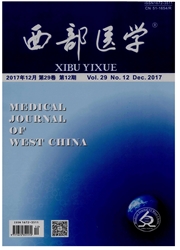

 中文摘要:
中文摘要:
目的研究中国汉族人群中组织激肽释放酶基因调节区多态性与原发性高血压的关系。方法选择无糖尿病、肾功能障碍和甲状腺功能亢进等疾病的中老年人群(30~70岁),以有无原发性高血压分为高血压组和对照组,采用聚合酶链反应(PCR)技术检测等位基因,基因分型采用等位基因特异性寡核苷酸分析(ASO)。统计分析采用t检验和Х^2检验。结果病例组及对照组选择符合哈迪-温伯格定律(高血压组,P=0.313;对照组,P=0.457);发现病例及对照间有9个等位基因存在明显不同(Х^2=25.701,P〈0.001),其基因型也存在显著差别(Х^2=70.100,P〈0.001)。结论中国汉族人群组织激肽释放酶基因调节区存在多态性,其基因及基因型在高血压患者和对照人群中的差别提示该住点的基因多态性与高血压的发生存在相关性。
 英文摘要:
英文摘要:
Objective A case control study was conducted in 200 hypertensive and 200 normotensive subjects of unrelated Chinese Han origin. Methods All subjects were aged from 30 to 70 years and had no history of diabetes mellitus, kidney failure, or thyroid gland disease. The alleles were detected by polymerase chain reaction (PCR) and genotyping was performed with allele specific oligonucleotide analysis (ASO). Data from the essential hypertensive and control subjects were statistically analysed by the Student's t test and Х^2 test. Results The age and gender matching of the groups were accurate. The case group and the control group were in Hardy Weinberg equilibrium at this locus. There were nine alleles among the case and control groups, and the allele frequencies were found to be significantly different be- tween cases and controls. The genotype frequencies were also significantly different between these two groups. Conclusion There are polymorphisms in the regulatory region of human tissue kallikrein gene in the Chinese Han people.
 同期刊论文项目
同期刊论文项目
 同项目期刊论文
同项目期刊论文
 Circadian blood pressure and heart rate characteristics in haemorrhagic vs ischaemic stroke in Chine
Circadian blood pressure and heart rate characteristics in haemorrhagic vs ischaemic stroke in Chine 期刊信息
期刊信息
